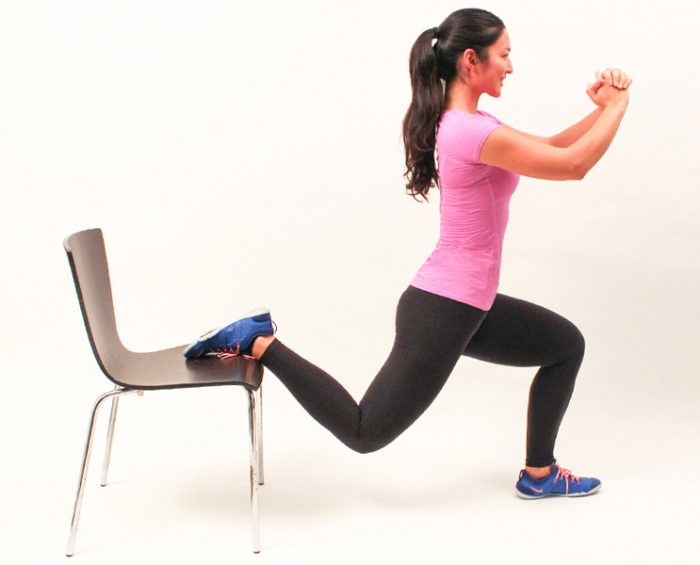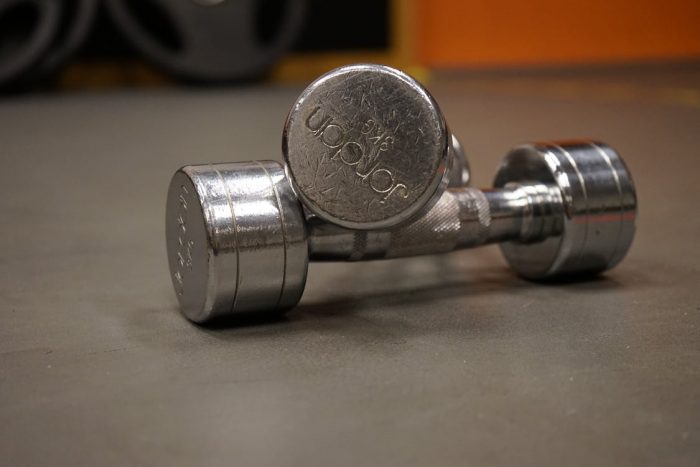It can often be difficult to squeeze in much extra time for any additional squash-specific conditioning training beyond your usual on-court sessions, so it’s important that anything that you do add really maximises the time you have available. One of the exercises you’ll often see in many of our sessions and programmes here on the site that really fits the bill is the rear foot elevated split squat – a favourite of many top sports performance specialists and athletic trainers such as Eric Cressey and Mike Boyle.
The rear foot elevated split squat (RFESS), also often known as the Bulgarian split squat, is a variation of the standard split squat or ‘static lunge’ exercise. The exercise set-up is similar to the end position of a lunge, but with the key differentiation of the back leg being elevated on a step, bench, or small platform. Obviously, the lunge exercise is one of the primary movement pattern that squash players should be practising, but adding in some RFESS sets to your training programme can have a number of additional benefits.
Firstly, it allows you to really shift the load and force the front leg to work that much harder. While perhaps not a true unilateral exercise due to the small contribution from the back leg, the front leg will take the bulk of the load through the movement. A lot of squash players have significant strength discrepancies between their dominant and non-dominant sides, so the RFESS can be a great way to apply a little more specific focus to bring your weaker side up to speed.
The movement works the two primary muscle groups in the leg, the quads and the glutes. Both areas are of key importance to the squash player, due to their functions of extending the leg and generating force to allow for stronger, more powerful movements. The position of the body during the RFESS exercise can really help encourage the glutes to engage more, which is important for many athletes who can often become too quad-dominant.
 Another benefit to the RFESS is the relative simplicity of the exercise. Where some of the more traditional lower body compound lifts such as the squat and deadlift require detailed coaching and a certain level of proficiency to be safely utilised, in comparison the RFESS is far simpler to learn and generally safer for most exercisers to perform. While occasionally some people may find some slight discomfort whilst performing the exercise, usually either reducing the step height or increasing the step distance away from the bench can quickly and easily remedy this.
Another benefit to the RFESS is the relative simplicity of the exercise. Where some of the more traditional lower body compound lifts such as the squat and deadlift require detailed coaching and a certain level of proficiency to be safely utilised, in comparison the RFESS is far simpler to learn and generally safer for most exercisers to perform. While occasionally some people may find some slight discomfort whilst performing the exercise, usually either reducing the step height or increasing the step distance away from the bench can quickly and easily remedy this.
No real additional equipment is required either. A small step, some stairs, or even a secured chair or bench can all be used to provide the elevation for the rear leg, with the only additional equipment that may be required is a set of dumbbells to increase the intensity of the exercise.
Finally, and perhaps the most significant benefit for many players is the way that the RFESS can be adapted in simple ways to allow you to focus on different elements of conditioning.
Once the basic technique of the exercise has been learnt, just going through some controlled reps of the exercise can be great to help mobilise key muscles in and around the hip area. Adding in a little work on the RFESS to a warm-up or dedicated mobility session can thus be very useful for the squash player.
If you’re completely new to the exercise, just performing a few reps may feel very difficult – indeed, the RFESS is included as one of our initial strength tests here on the site. As you get more proficient however, you’ll find you’ll be able to perform more and more reps working with just your bodyweight. Pushing yourself here into ranges of around 15 to 20 reps will really cause you to feel a burn in the quads and glutes, making for a great squash-specific muscular endurance workout.

Once you’re comfortable with the exercise, simply reducing the reps and adding in some external resistance with the use of some dumbbells held to the side or a barbell across the shoulders, can also really help build squash-specific strength and stability. Due to the nature of the exercise, external loads will never approach those used while squatting or deadlifting, making it a potentially better alternative for those with lower body joint issues.
So mobility, endurance, and strength/stability all in one quick and simple to learn exercise. Try adding in a few sets of the RFESS into your programme a couple of times a week, and see how it benefits your physical performance – members can check out our technique video here.
Gary Nisbet
B.Sc.(Hons), CSCS, NSCA-CPT, Dip. FTST
SquashSkills Fitness & Performance Director